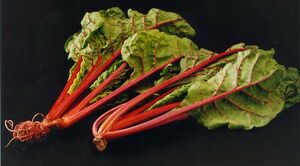
Swiss chard
Name Variations[]
- chard chard
- spinach beet
- leaf beet
- seakale beet
- silver beet
- white beet
About Swiss chard[]
Wikipedia Article About Swiss Chard on Wikipedia
Chard (Beta vulgaris var. cicla), also known as Swiss Chard, Silverbeet, Perpetual Spinach or Marigold, is a leaf vegetable, and is one of the cultivated descendents of the Sea Beet, Beta vulgaris subsp. maritima. It is in the plant family Amaranthaceae along with Spinach. The word cicla refers to Sicily where Swiss chard first grew.
Its popular name stems from the fact that a Swiss botanist determined the plant’s scientific name. Today, Swiss chard is most popular in the Mediterranean. Swiss chard can also be found in northern Europe and South America.
While used for its leaves, it is in the same species as the garden beets, which are used for their roots, including Mangelwurzel which is used for animal feed and the sugar beet which is used to make sugar.
There are several cultivars of chard available for growing, but the most common is Swiss Chard. Other varieties are "Ruby chard", "Rainbow chard", and "Rhubarb chard".
Chard has shiny green ribbed leaves, with stems that range from white to yellow and red depending on the cultivar. It has a slightly bitter taste. The leaves are generally treated in the same way as spinach and the stems like asparagus. Fresh young chard can also be used raw in salads. The leaves can be smooth or curly and are attached to fleshy, crunchy white, red or yellow celery-like stalks.
Swiss chard is an excellent source of vitamins A and C.
Preparation of Swiss chard[]
Prior to cleaning Swiss chard, any wilted or yellow leaves should be removed. Next, dunk the chard into a bowl of tepid water a few times to clean. Drain and use a salad spinner to dry greens for use in salads. For use in cooking, it is not necessary to completely dry leaves.
Traditionally, greens are boiled or simmered very slowly with a piece of ham hock for an extended period of time until they are quite soft. This softens the texture and decreases some of their bitter flavor. Greens can also be steamed, microwaved, added to soups, salads, stews, and other dishes.
To decrease the bitterness of greens, blanch them in boiling water for approximately one minute prior to cooking (though this does diminish some if their nutritional value), the color, flavor and texture will be preserved. Greens can than be sautéed (do not use aluminum or iron pans), or added to various dishes during cooking.
